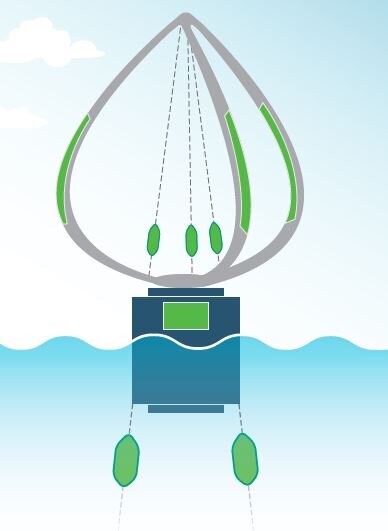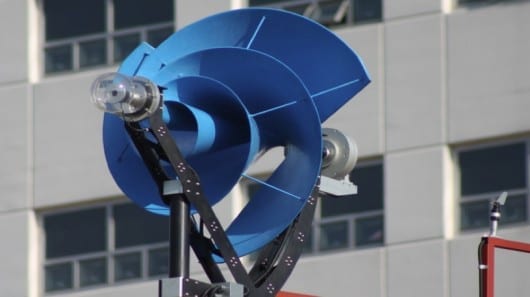
Sandia National Laboratories’ innovative design for offshore wind: no heavy tower, instead wind blades pulled taut with guy wires.
(Illustration by Brent Haglund)
New Sandia software allows for design of innovative floating turbines
Brandon Ennis, Sandia National Laboratories’ offshore wind technical lead, had a radically new idea for offshore wind turbines: instead of a tall, unwieldy tower with blades at the top, he imagined a towerless turbine with blades pulled taut like a bow.
This design would allow the massive generator that creates electricity from spinning blades to be placed closer to the water, instead of on the top of a tower 500 feet above. This makes the turbine less top-heavy and reduces the size and cost of the floating platform needed to keep it afloat. Sandia filed a patent application for the design in 2020.
However, before he could set his idea in motion, the team needed to build software capable of modeling the response of the turbine and floating platform to different wind and sea conditions to determine the optimal design of the whole system.
Now, the Sandia team have a functional design tool, or “drawing board,” and can start designing and optimizing their lighter floating wind turbine system.
“To design our floating wind turbine system, we needed a design tool that can simulate the wind, waves, blade elasticity, platform motion and the controllers,” Ennis said. “There are a few tools that can do some of what we need but without all of the pertinent two-way coupled dynamics for design and optimization of this kind of wind turbine. It was a big undertaking, but it was essential. There can’t be a floating, vertical-axis wind turbine industry without a trusted tool like this.”
Lighter, cheaper turbines for ovffshore wind
Much of the U.S.’s offshore wind blows across water more than 200-feet deep. At those depths, it would be very expensive to build the rigid support structures typically used by wind turbines. However, wind turbines that can float above the sea floor could play an important role in diversifying our sources of renewable energy and improving the stability of the grid as cities and states move closer to achieving their net-zero emission goals, said Ryan Coe, a mechanical engineer in Sandia’s water power group.
“The high electrical demand on the coasts is one reason why offshore wind looks attractive; people tend to live away from where the onshore wind is the strongest and there’s not enough space in cities for solar panels,” Coe said. “Also, offshore wind provides power at different times of the day than solar and onshore wind.”
However, floating offshore wind does come with its own challenges, Ennis added. Chiefly, it is very expensive to support the wind turbines and to maintain them when they’re out at sea. The goal of one Department of Energy Advanced Research Project Agency-Energy program is to optimize the design of floating wind turbines, platforms and control systems to maximize power output while minimizing costs, he said.
“For us the question becomes how do we remove mass and cost from the system while maximizing energy capture, which is where we got our innovative, towerless, vertical-axis design,” Ennis said.
Most wind turbines today are based around a tall tower with three blades turning a horizontal shaft that cranks a generator behind the blades in the turbine’s nacelle, the box at the top of the turbine that contains the rotor and other important components. But that’s not the only way to design a wind turbine, Ennis said. Some turbines have two or more blades supported by a vertical shaft with a generator below the blades. This design, called a Darrieus vertical-axis wind turbine, has a lower center of gravity and can weigh less than a traditional wind turbine, Ennis said, but one of its main challenges is that it’s difficult to protect the turbine from extreme winds.
For traditional, horizontal-axis wind turbines, the blades can rotate away from intense, damaging winds, but the Darrieus design catches the wind from every direction. The Sandia design replaces the central vertical tower with taut guy wires, Ennis said. These wires can be shortened or lengthened to adjust for changing wind conditions to maximize energy capture while controlling strain. Additionally, replacing the shaft with wires reduces the weight of the turbine even more, allowing the floating platform to be even smaller and less expensive.
Original Article: Back to the drawing board: Reinventing offshore wind turbines
More from: Sandia National Laboratories | Advanced Research Projects Agency-Energy
The Latest Updates from Bing News
Go deeper with Bing News on:
Vertical-axis wind turbine
- HWUM and Harvey Mudd College, USA, Collaborate for Marina Pangkor Excursion Project
Marina Pangkor excursion project was a significant collaborative effort between students from our Malaysia campus and HMC.
- Wind Harvest Surpasses $500K Milestone on Netcapital, Offers Limited-Time Discounted Shares
Davis, California, April 23, 2024 (GLOBE NEWSWIRE) -- Wind Harvest, a leading innovator in renewable energy technology, has achieved a significant fundraising milestone, surpassing $500,000 on the ...
- Mumbai airport sees 16 per cent surge in passenger traffic this fiscal year
In the fiscal year 2023–24, Chhatrapati Shivaji Maharaj International Airport (CSMIA) experienced a notable surge in passenger traffic, welcoming over 52.8 million travellers, marking a 16 per cent ...
- Chhatrapati Shivaji Airport (CSMIA) records surge in passenger traffic, global connectivity in FY 2023-24
According to a press release, the airport also accommodated 324,972 Air Traffic Movements (ATMs), recording a 12 per cent year-on-year growth rate compared to FY 2022-23 (290,387 ATMs).
- PNOC, Indian firm to roll out hybrid tech for off-grid areas
State-run Philippine National Oil Co. (PNOC) said Monday it plans to deploy Solar Mill technology across small island communities under its memorandum of understanding (MOU) with WindStream Energy ...
Go deeper with Bing News on:
Floating wind turbines
- Floating tidal energy turbine company to make waves in US waters: 'This milestone underlines growing global appetite'
Scotland-based Orbital Marine Power, the company that created the O2, the floating tidal turbine off Orkney in Scotland that went online in 2021, is in the process of deploying that same technology ...
- New Cranes & Offshore Wind Efficiency
The end may be in sight, but the race for bigger cranes is still having an impact on offshore wind project efficiency.The ...
- Mills opens public comment on offshore wind plan
Maine initiated its next step in the process of procuring offshore wind by asking for public input to inform future planning. According to a news release Wednesday from the Governor’s Energy Office, ...
- Octopus Energy invests in Ocergy to boost floating offshore wind energy worldwide
Octopus’ investment, through Vector, will boost the commercialization of Ocergy’s technology and accelerate its expansion into new markets. It will also support the development of its advanced ...
- Octopus Energy makes strategic investment in US-based Ocergy
The floating offshore wind technology company is at the forefront of adopting a hyper-local supply chain strategy.










